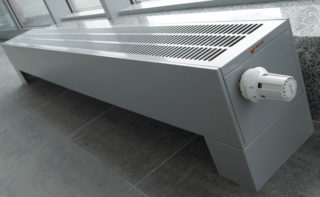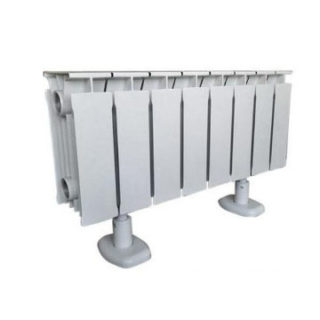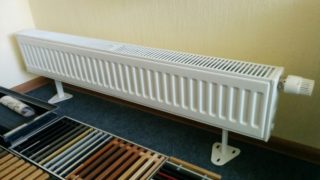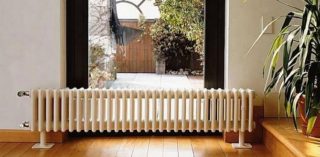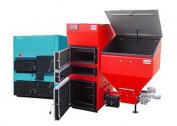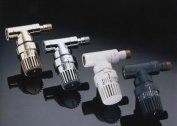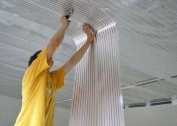Floor batteries are used for heating rooms with panoramic windows and windows. They prevent icing of the window surface, evenly warm the room. Floor radiator is suitable for a residential or country house, office. For the right product selection, you need to familiarize yourself with the varieties, characteristics and features.
Advantages and disadvantages of floor models
The floor radiator can be installed on special legs or built into the surface of the floor, fixed as a plinth. Compared with standard options, they have several advantages:
- compactness - small-sized products do not clutter up the space;
- high heat transfer coefficient of models made of cast iron, bimetal, aluminum;
- laconic appearance - suitable for any interior solution;
- several color options - standard batteries are made in white, but manufacturers paint them according to the RAL-catalog, beating different textures;
- ease of installation - installation work is reduced to connecting to the heating system or screwing it into the floor;
- efficient heating of a room with a large window;
- the ability to install near the walls.
The disadvantages of floor heating radiators include the need for floor wiring, the difficulty of finding the right model in offline stores. Among the shortcomings are also noted a low price in comparison with the classic options and heating by convection technology.
The outdoor appliance can be combined with a classic battery near the wall or under the windowsill.
Features of choosing a device for heating a house
When buying a heater, several factors must be considered:
- The material of manufacture. Aluminum are lightweight, compatible with any coolant. Bimetallic ones are less susceptible to corrosion, while cast iron ones have the highest heat capacity.
- Construction. Sectional options are easy to select for window parameters due to the ability to remove or add items. The panels heat up quickly and are easy to install. Tubular are resistant to pressure fluctuations and withstand a load of up to 20 atm.
- Dimensions and specifications. The height of the floor devices is from 14 to 50 cm, and the length is up to 2 m. They are designed for pressure up to 15 atm. and water temperature up to 110 degrees.
- The heating method and form. Water batteries are heated from the coolant, equipped with temperature controllers. Electric ones can work together with the “warm floor” system, while combined ones operate from the heating line and the mains.
For installation in the bathroom, it is better to choose skirting modifications that will save up to 40% of fuel.
Floor Battery Specifics
Floor-standing batteries are replaced by ordinary ones if you need to open the space without masking the facade. A center distance of 20 cm will emphasize the panoramic type of glazing. Devices are connected to the highway floor or side way, depending on the output pipes. To control the intensity of heating and temperature conditions, rooms can be equipped with thermostat valves and taps.
In a complex with panoramic windows, the heaters look beautiful and neat.Thermal return depends on the number of sections and is comparable to standard indicators with an interaxial distance of 0.35 m.
Operating principle
As a component of a water heating system, floor units function as follows:
- Heating the coolant in the boiler room to the desired temperature.
- Piping water and filling batteries.
- Case heating.
- The supply of thermal energy to the room through radiation or convection.
According to the principle of radiation, only panel and section batteries operate, which takes up to 80% of the total power. Thermal waves are directed perpendicularly or in two directions at an angle.
Models with a fin radiator tube transfer heat according to the principle of convection. Heated air moves in the room toward the ceiling and displaces the cold.
Types of materials for floor radiators
Water floor devices - batteries for heating a house or apartment, are made of several materials.
Aluminum
They are produced using casting technology (casting a whole unit) or extrusion (connecting individual parts). They have increased heat transfer, so they quickly heat up. Aluminum batteries are the best option for a home autonomous system. They differ:
- working pressure of 5-16 atm .;
- thermal power of one section from 81 to 212 W;
- compatibility with the heat carrier with a maximum temperature of 110 degrees;
- efficiency at a pH of 7-8.
When choosing aluminum modifications, it is necessary to make calculations according to the area of the room and additionally purchase pressure sensors, temperature sensors, and mud filters.
Bimetallic
Bimetal heaters are made with a steel inner core and an aluminum body. Due to the insensitivity to the composition of the water with the help of appliances, an office or apartment can be heated.
An anti-corrosion coating is applied to the internal and external parts of the product, which prevents the appearance of rust, wear of nodes. Radiator systems can withstand water hammer and a maximum pressure of 50 atm.
Depending on the materials used, there are designs of 100% (steel core and aluminum body) or 50% (steel vertical pipes) of bimetal. Both types are different:
- working pressure limit of 18-40 atm .;
- thermal power of a separate section from 125 to 180 W;
- extreme temperature of the heat carrier from 110 to 130 degrees.
Bimetal options are lightweight, look beautiful, but are expensive.
Cast iron
They have the form of cast sections hermetically fixed to each other. The cast-iron type of batteries is suitable for an apartment and is selected according to the total area, number of windows, number of storeys, and arrangement of rooms.
The design is characterized by high heat dissipation, long operational period and insensitivity to chemical influences. Cast iron can accumulate and retain heat for a long period. The minus of the metal is its large weight and breaks due to pressure drops.
Heaters have the following characteristics:
- maximum pressure limit of 18 atm .;
- the highest heat carrier temperature of 150 degrees;
- power of one section from 100 to 150 watts.
The main advantage of cast iron is its wear resistance, which does not depend on the composition of water.
Possible alternatives
Floor-type radiators, if necessary to create an aesthetic design, can be replaced by other devices.
Embedded Options
The floor-mounted unit allows you to lay heating in a hidden way. It is installed in the floor, and a decorative grill is used to output heat energy, which is on the same level as the coating.Built-in modifications differ:
- ability to withstand pressure from 10 to 16 bar;
- thermal power from 13 to 100 kW;
- the limit of water heating from 110 to 130 degrees;
- simplicity of design, light weight and compactness;
- resistance to corrosion;
- hidden location - mounted in a doorway or floor covering;
- uniform heating of the room;
- preventing fogging of window structures.
For reasons of large installation length and the need to make a niche, it is better to design the location of the sections at the construction stage. Models work only on the principle of radiation, so their heat transfer is minimal.
Skirting Convectors
The bathroom does not always have the ability to build batteries, so you can stay on the warm skirting boards. Products differ:
- height from 20 to 25 cm and a depth of 10 cm;
- efficiency - fuel costs are reduced by 50%;
- thermal power from 50 to 150 kW;
- working pressure limit up to 16 atm .;
- heating water to 130 degrees;
- protection against overheating thanks to a temperature regulator;
- ease of installation;
- uniform distribution of heat flows.
Floor heating radiators should only be installed by specialists. If technology is not followed, wall decoration can be ruined.
Connection Features
Regardless of the design, floor heaters are connected to the system according to the principle of standard modifications with a lower type of connection:
- The heat exchanger pipe is located in the legs or supports, so it does not need to be masked.
- The brackets are adjusted in height, their alignment with a building level.
- Auxiliary brackets are screwed to the floor surface.
- The radiator is fixed to the legs or body.
- A temperature control knob is placed on the side.
At the last stage, the quality of the connections is checked and binding is performed.
Floor models of radiators do not take up much space, therefore, they are combined with panoramic glazing. When choosing a device, it is necessary to focus on the material of manufacture, the number of sections and thermal efficiency.


